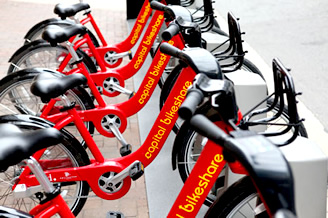The prevalence of bicycles in a community is an indicator of our ability to provide affordable transportation, lower traffic congestion, reduce air pollution, increase mobility, and provide exercise to the world’s growing population. Bike-sharing programs are one way to get cycles to the masses.
In early 2014, some 600 cities in 52 countries host advanced bike-sharing programs, with a combined fleet of more than 570,000 bicycles.
Spain leads the world with 132 separate bike-share programs. Italy has 104, and Germany, 43.
The world’s largest bike-sharing program is in Wuhan, China’s sixth largest city, with 9 million people and 90,000 shared bikes.
In 2013, China was home to 82 bike-sharing programs, with a whopping combined fleet of some 380,000 bicycles.
The United States hosts 36 modern bike-sharing programs. With a number of new programs in the works and planned expansions of existing programs, the U.S. fleet is set to nearly double to over 37,000 publicly shared bicycles by the end of 2014.
Since the Vélib’ system launched in Paris in 2007, the number of cyclists on the streets has risen 41 percent. Nearly 24,000 bicycles can be picked up at over 1,700 stations in the city and suburbs.
London’s Barclays Cycle Hire system launched in 2010 with 6,000 bikes and has grown beyond 9,000. New bike lanes and designated cycle tracks have helped ridership grow.
Bike-sharing cities are finding that promoting the bicycle as a transport option can lead to more mobility and safer streets for all.
Bike shares, lanes, and other bicycle-friendly infrastructure are a boon to local economies.
With more than half the world’s population now living in cities, there is tremendous potential for municipal governments and urban planners to increase bicycle use.
With annual memberships in most cities well below $100, bike sharing is far cheaper than the $7,800 average cost estimated by AAA to own a car and drive it 10,000 miles a year.
During the first year that people abandon regular driving to become a bike commuter, they can lose 10 pounds or more.
Data and additional resources available at www.earth-policy.org.



